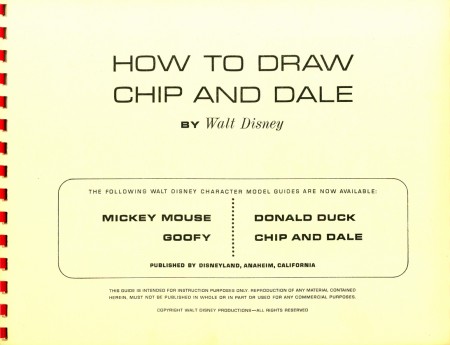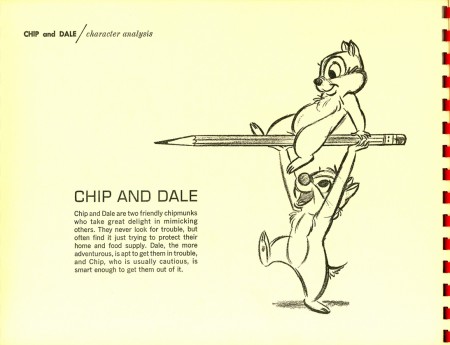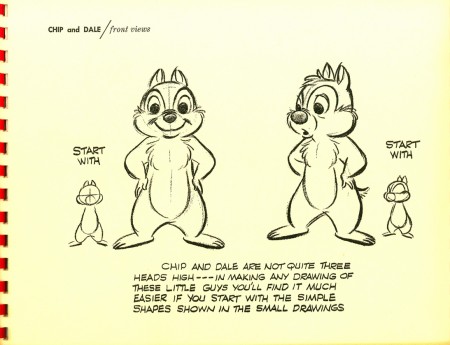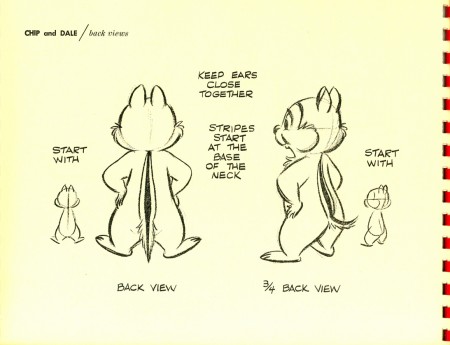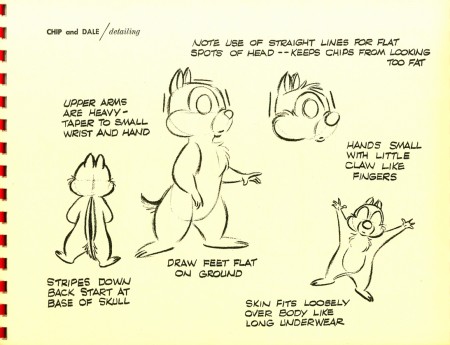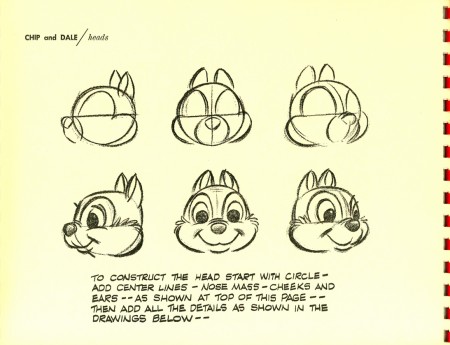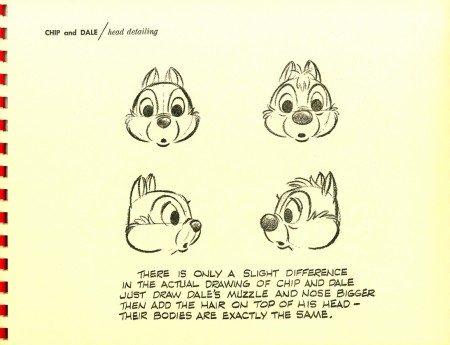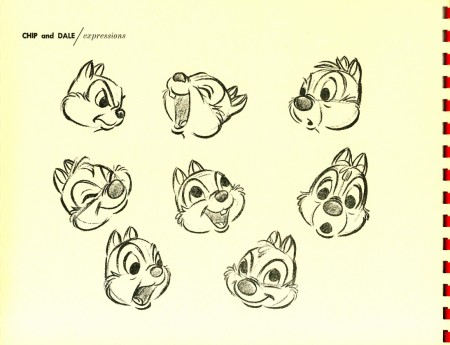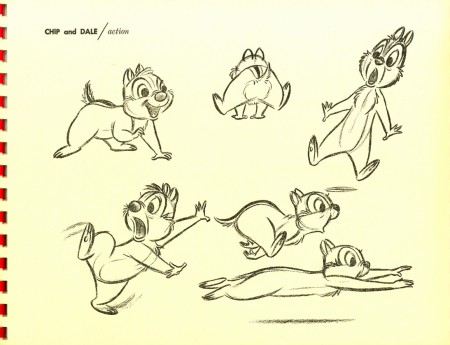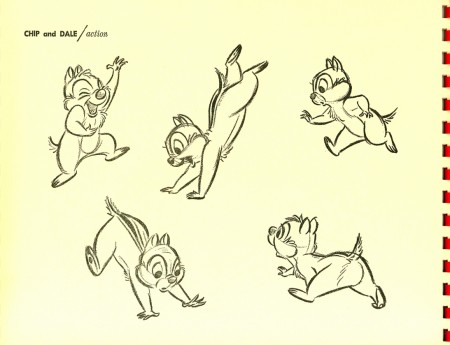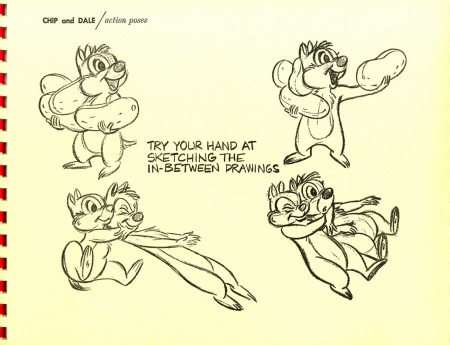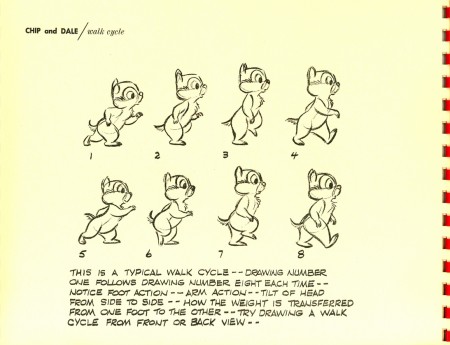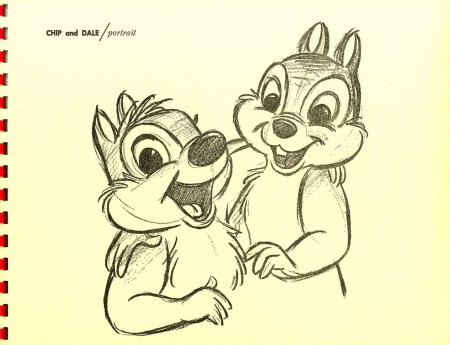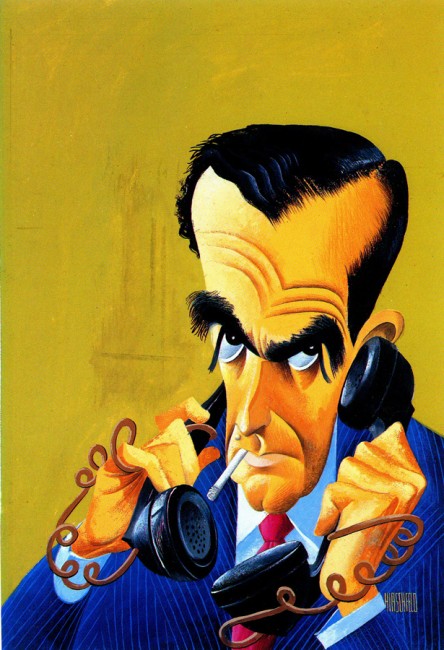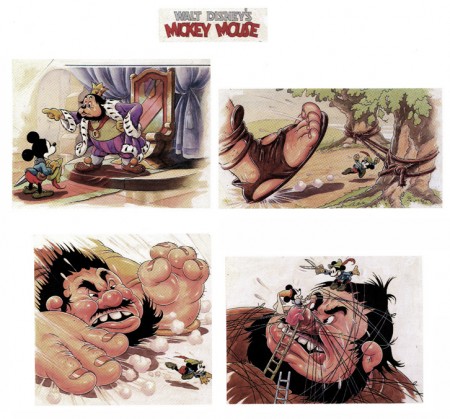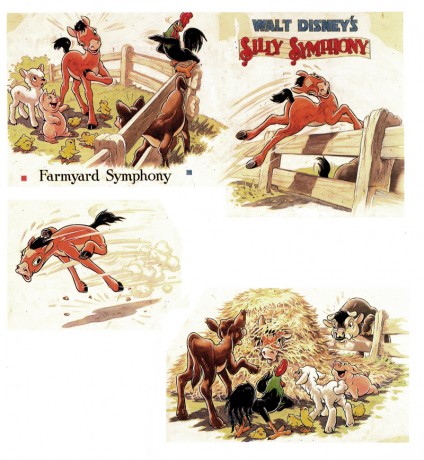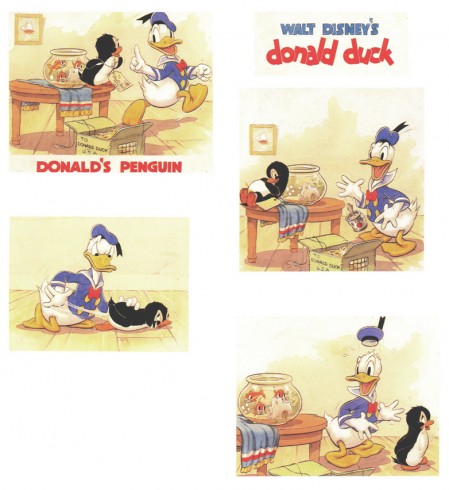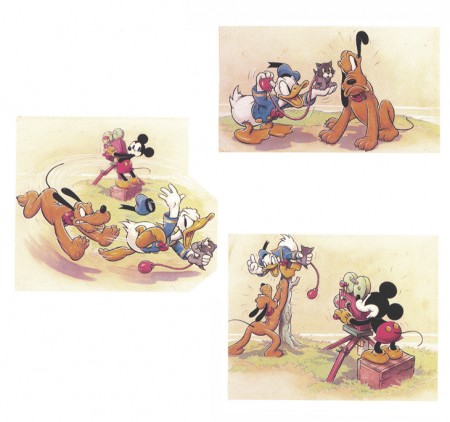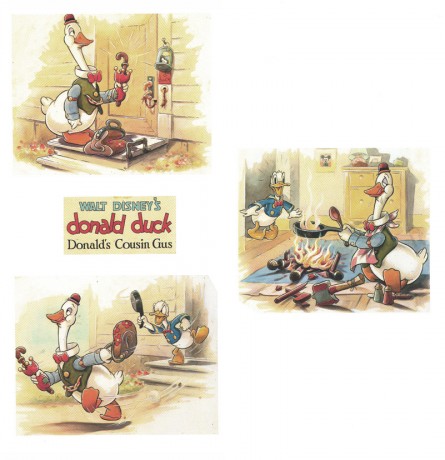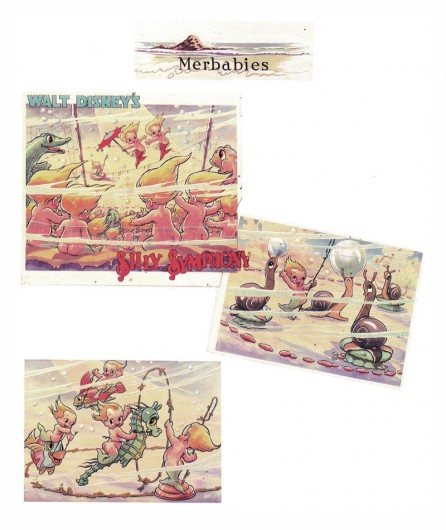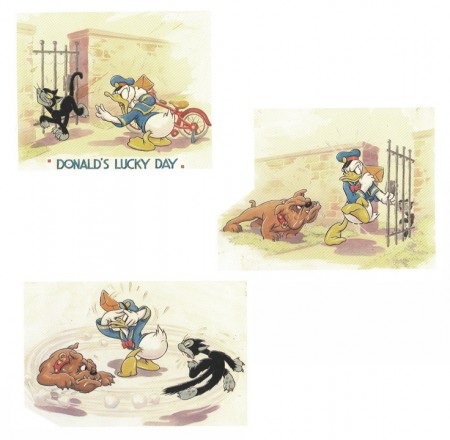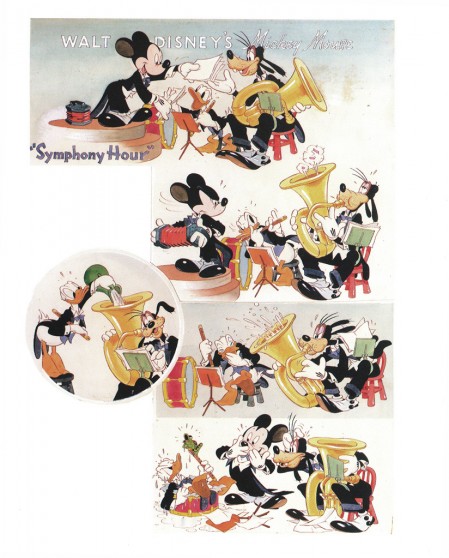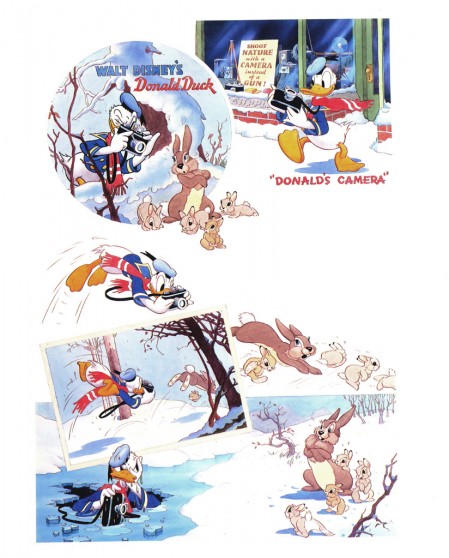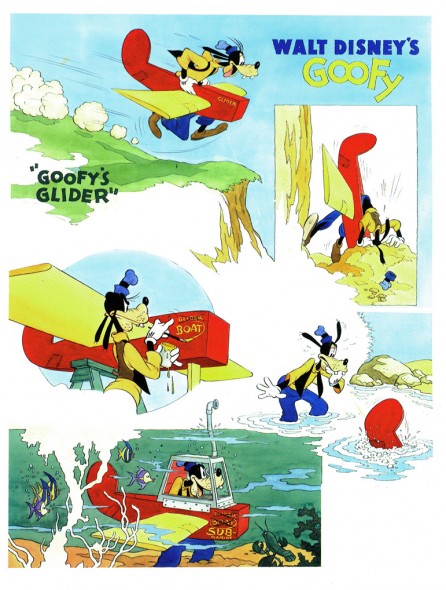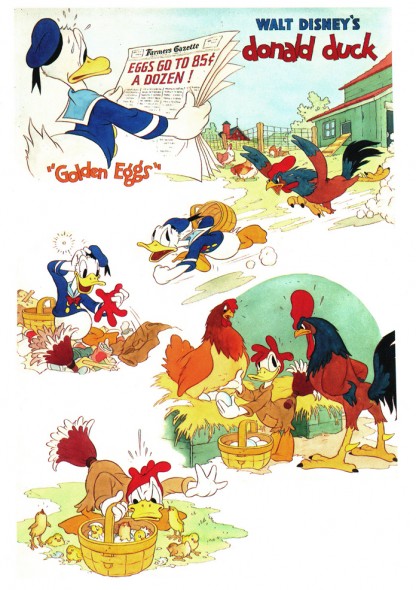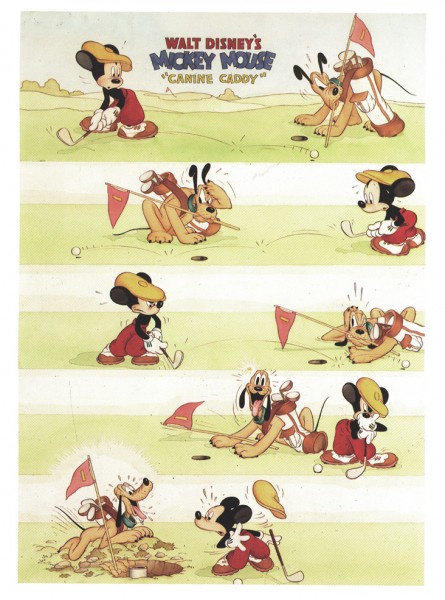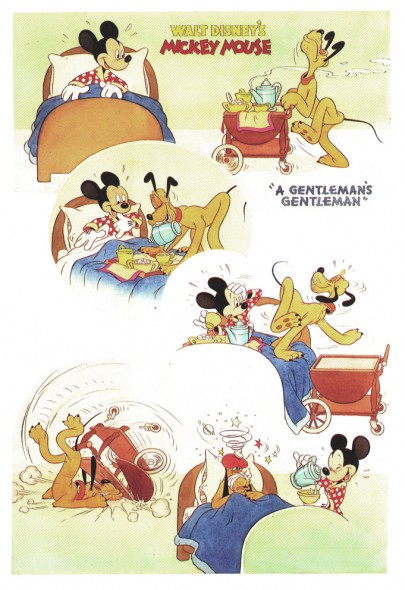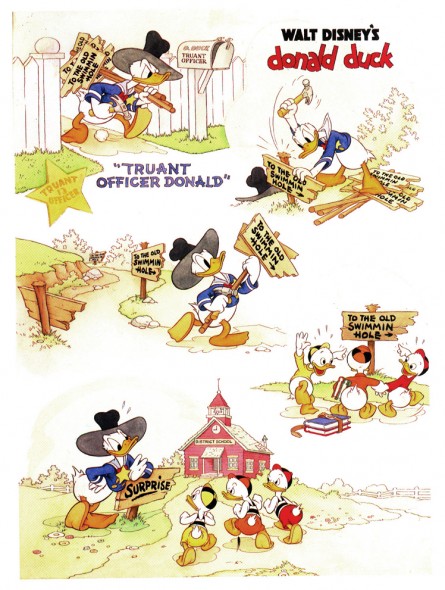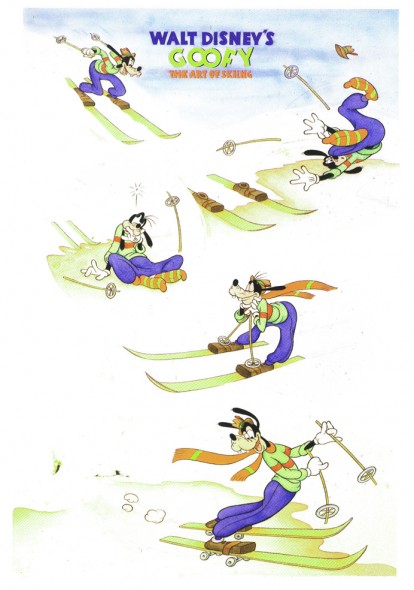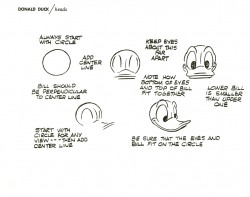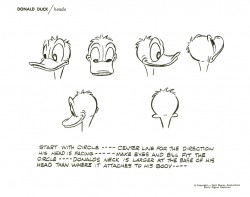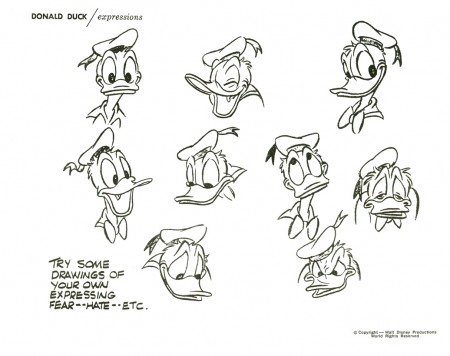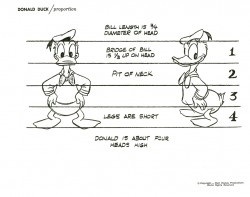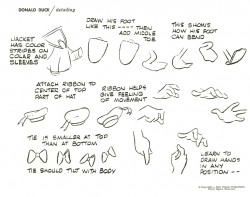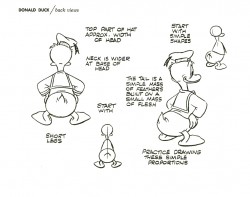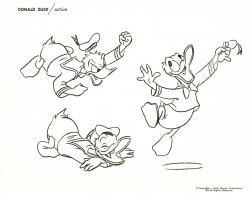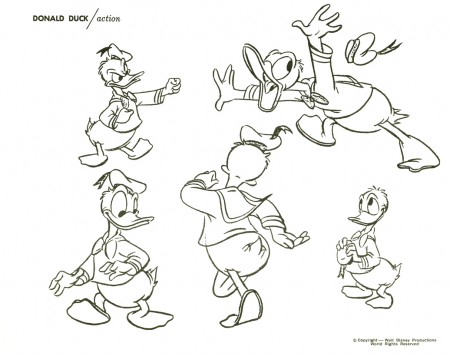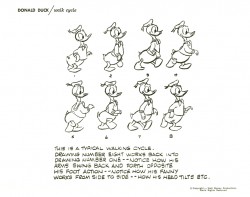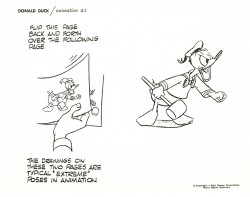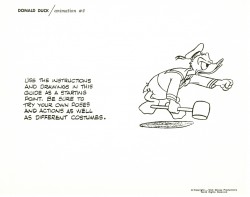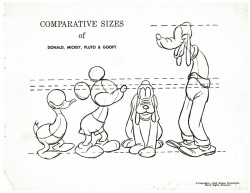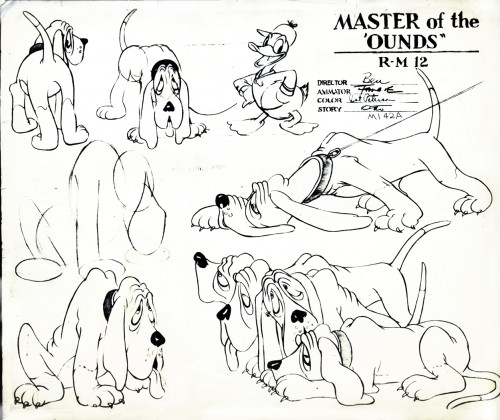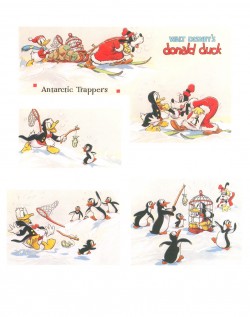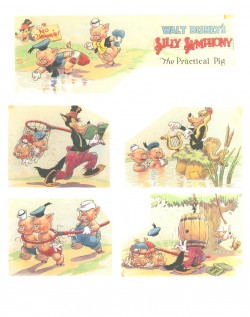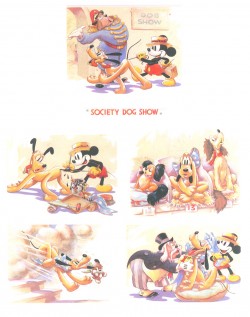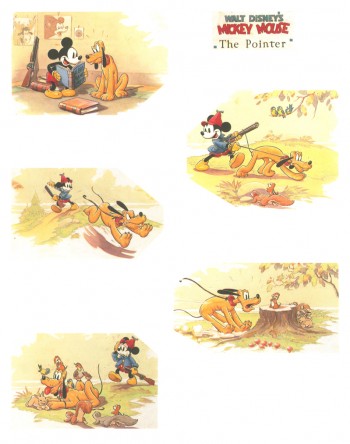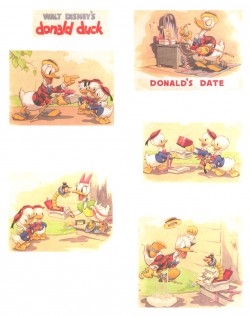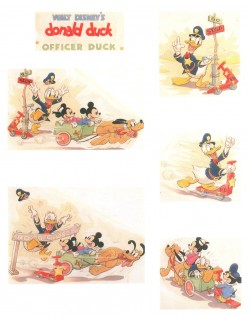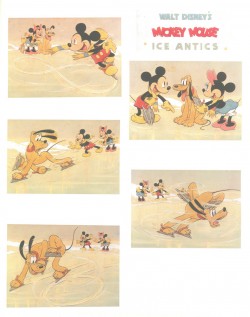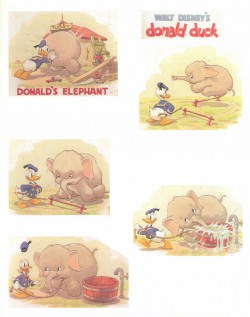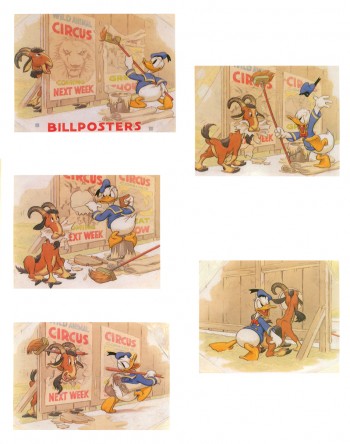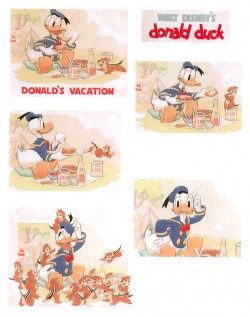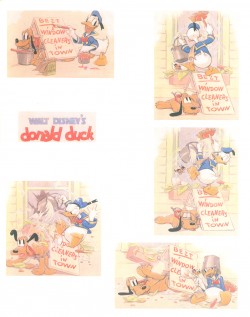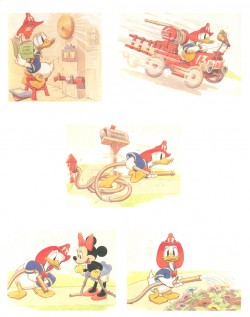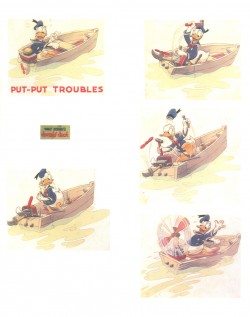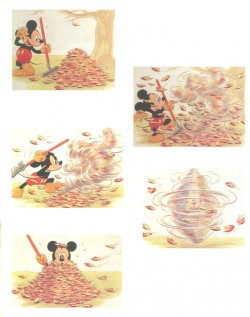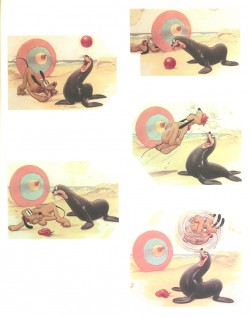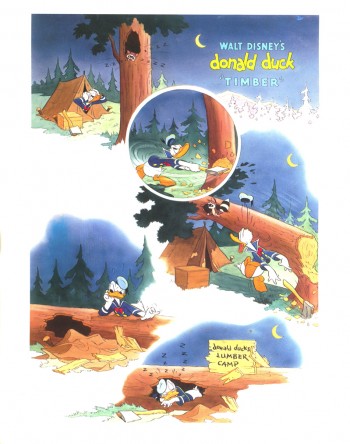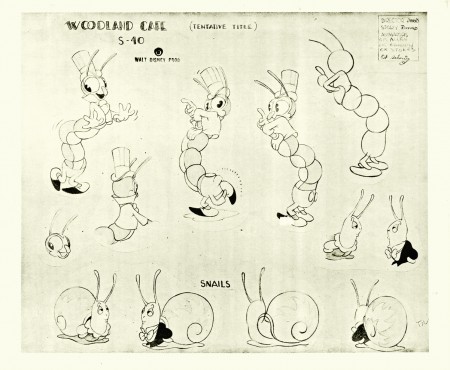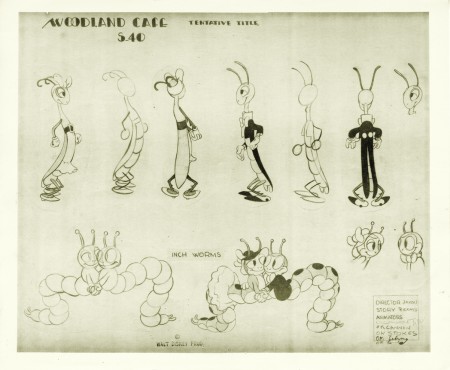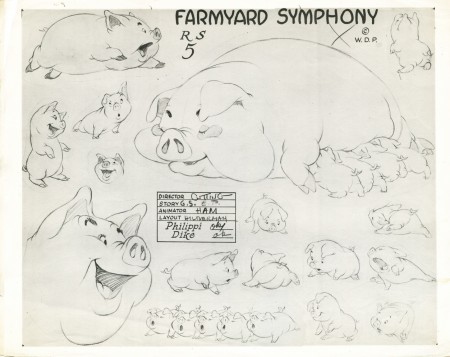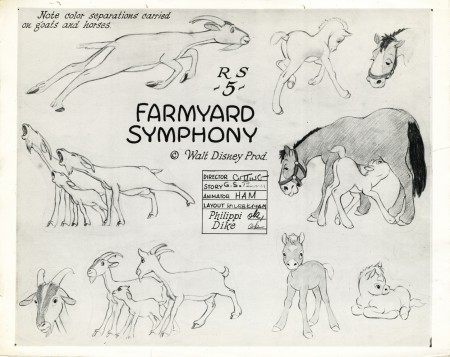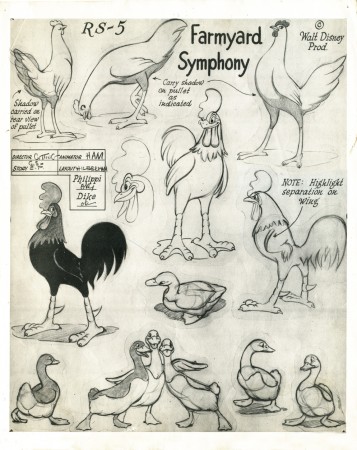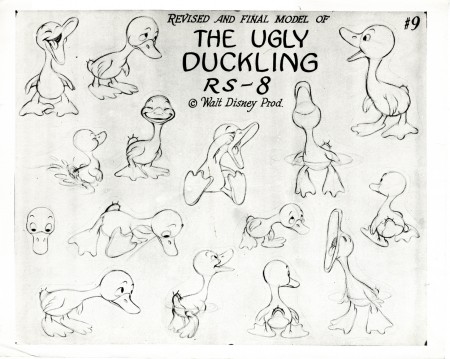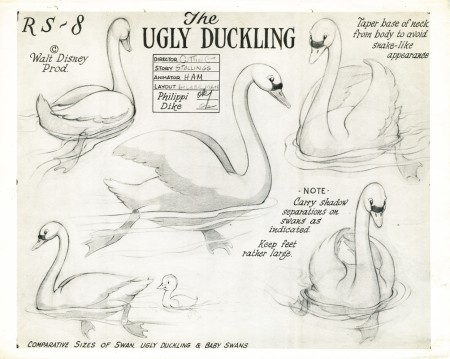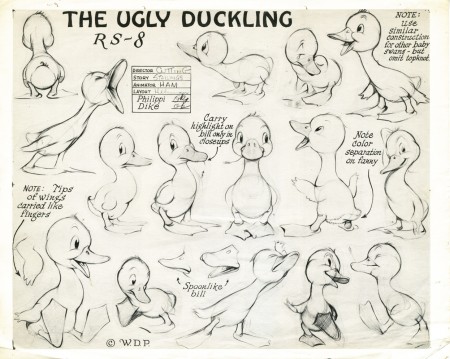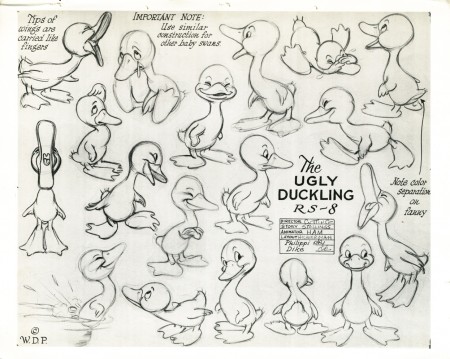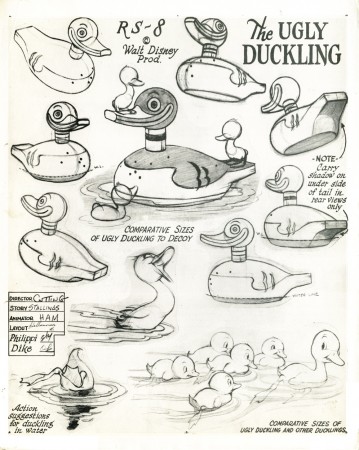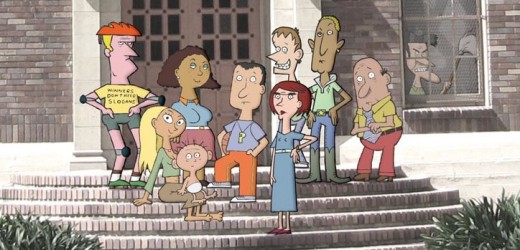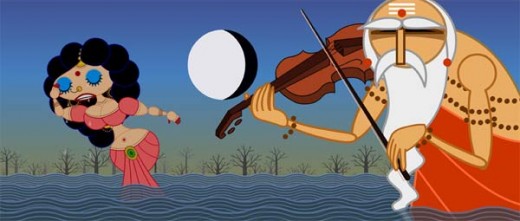Search ResultsFor "1939"
Animation Artifacts &Bill Peckmann &Books &Disney &walk cycle 08 Oct 2009 08:28 am
How To Draw Chip & Dale
- In the past I’ve posted the series of booklets that Disney released via the Art Corner at Disneyland. How To Draw Mickey, Donald, Goofy and Pluto have been posted. The only one left is How To Draw Chip & Dale. Thanks to Bill Peckmann, I can post this last booklet.
The past booklets I posted were actually rereleased publications that were stapled together and handed out at the Lincoln Center celebration for all things Disney back in 1973.
This Chip & Dale book, however, is the real thing. It was an original published in 1955.
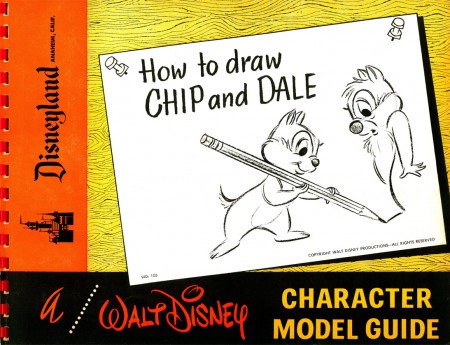 1
1(Click any image to enlarge.)
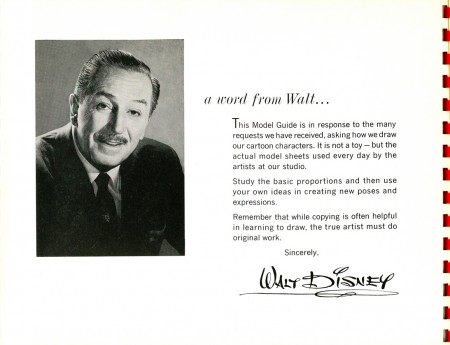 2
2
This is the inner cover which iss a thin cardboard.
as opposed to the yellow pages of paper.
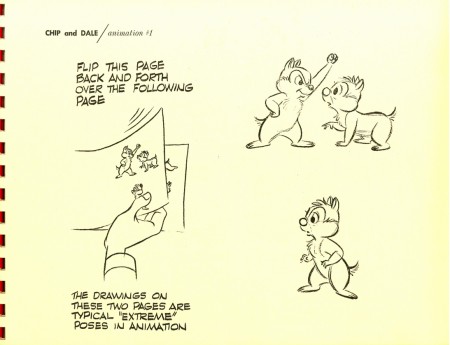 15
15
The directions tell you to flip the pages to see the movement.
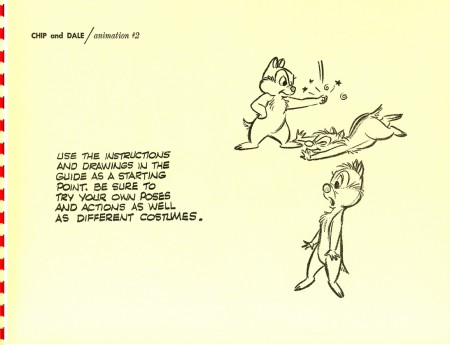 16
16
However this page is printed on the back of page 15,
and it’s impossible to flip. It doesn’t matter since the two drawings
aren’t registered to each other and flipping doesn’t work.
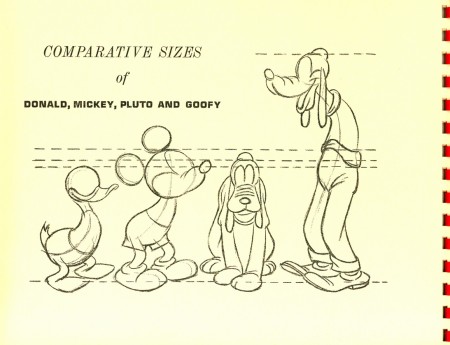 18
18
This page appears in all of the booklets.
Here’s a QT of the walk cycle on pg 12.
Chip cycle on threes.
Click left side of the black bar to play.
Right side to watch single frame.
Go here to see the lecture series posts:
Mickey / Donald / Goofy / Pluto
Here to see How To Draw Mickey.
Here to see How To Draw Donald.
Here to see How To Draw Pluto.
Here to see How To Draw Goofy (Jenny Lerew‘s Blackwing Diaries.)
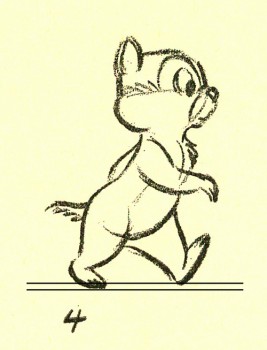
I once pointed out that a good walk should be drawn
with the two feet a distance apart from each other.
This creates a sense of depth in that walk. You might look
for this when you see other walks on line. You’ll be
surprised at how many professionals do it and how many
beginners don’t. Lately the latter is beating the former.
Bill Peckmann &Books &Commentary 30 Sep 2009 07:47 am
Snap Crackle Pop
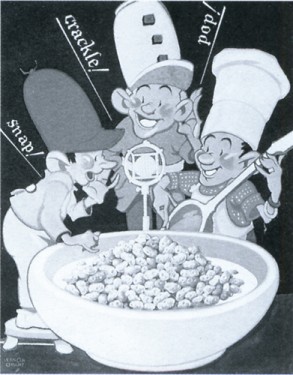
The original Snap, Crackle and Pop
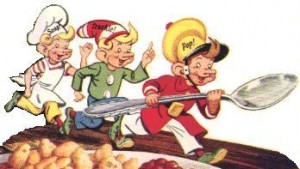 - Vernon Grant was the designer of the three elves who’ve appeared on the Rice Krispies package since 1928.
- Vernon Grant was the designer of the three elves who’ve appeared on the Rice Krispies package since 1928.
Snap, Crackle and Pop have gone through many incarnations since their debut. Their ears and noses have been reduced and softened, and their costumes have changed significantly.
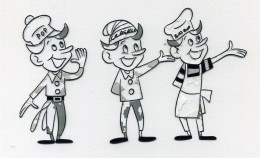
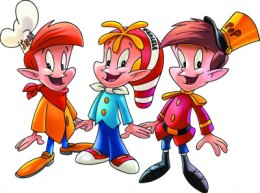
Two other variations found on liine. The left animated at Playhouse Pictures in the Fifties.
A couple of commercials can be found on YouTube. Naturally enough, the quality degenerates chronologically.
#1, #2, #3, #4, #5
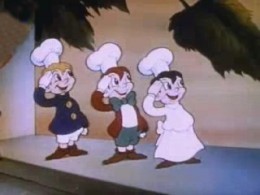 In 1939, Snap, Crackle and Pop starred in a short called Breakfast Pals. In the 1½ minute film, the three elves have to fight another three elves: Soggy, Mushy and Toughy. Ultimately, our heroes roll the bizzaro elves into a syrupy pancake and prepare Rice Krispie cereal for two boys sharing a sleep-over.
In 1939, Snap, Crackle and Pop starred in a short called Breakfast Pals. In the 1½ minute film, the three elves have to fight another three elves: Soggy, Mushy and Toughy. Ultimately, our heroes roll the bizzaro elves into a syrupy pancake and prepare Rice Krispie cereal for two boys sharing a sleep-over.
The film was made by Cartoon Films Ltd. This was the last incarnation of Ub Iweerks’ own studio. He was, at the time, making some short films for Columbia.
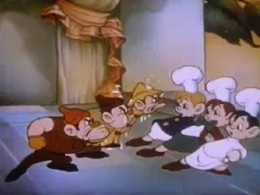
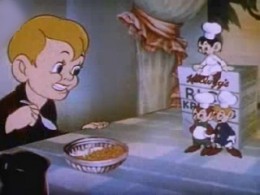
Soggy, Mushy and Toughy fight Snap Crackle & Pop
In 1939, the Kelloggs Corporation sent this letter which talks of other illustrations by Vernon Grant. Mother Goose rhymes were added to the package backs and became very popular. Kellogs sought to publish them.
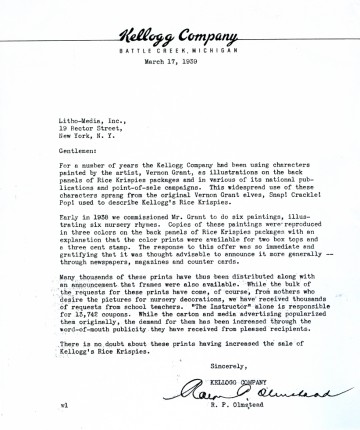
(Click any image to enlarge.)
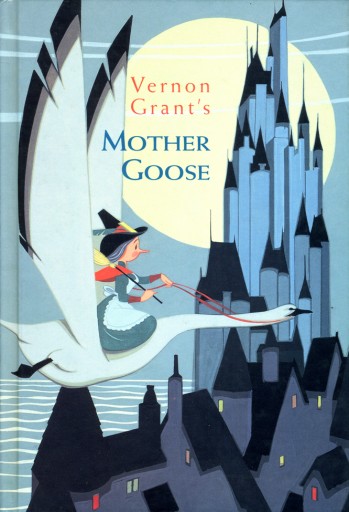
This is the subsequent book, which became
quite successful and is still available.
I’ll post the illustrations for the book tomorrow.
The letter and book are courtesy of Bill Peckmann to whom many thanks are offered.
Art Art &Commentary &Illustration 01 Sep 2009 07:32 am
Hirschfeld
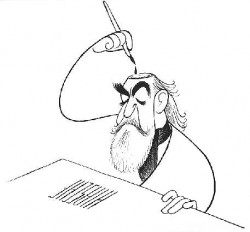 - Last week there were the noisy attacks pro and con of the 09 Ottawa Animation Festival poster. It climaxed with Amid Amidi’s turn on Pete Emslie’s artwork attacking his caricatures as: “. . .tired Hirschfeld impersonations”. This isn’t quite a bad put down considering the almost 70 year brilliance of Al Hischfeld’s caricatures. Hirschfeld was an artist of the highest calibre, and to say one’s work looked like his is to say it looks like a Matisse or a Picasso.
- Last week there were the noisy attacks pro and con of the 09 Ottawa Animation Festival poster. It climaxed with Amid Amidi’s turn on Pete Emslie’s artwork attacking his caricatures as: “. . .tired Hirschfeld impersonations”. This isn’t quite a bad put down considering the almost 70 year brilliance of Al Hischfeld’s caricatures. Hirschfeld was an artist of the highest calibre, and to say one’s work looked like his is to say it looks like a Matisse or a Picasso.
I was never a raving fan of Hischfeld’s work, though I couldn’t help but respect his lifelong consistency, clean art and beautiful ink work. However, when I went to an exhibit which toured NY through the Public Library a few years ago. This exhibit initiated at the National Portrait Gallery/Smithsonian and moved across the country.
It was after seeing this work, in person, that I began to see Hirschfeld himself. Somehow we ended up at the same venues for four or five occasions at this late point in his life. I was always too shy to go up to him to introduce myself.
Surprisingly, Hirschfeld’s caricatures were the stunning gems throughout the show. (There were also those beautiful Joe Morgan celebrity caricatures as well as setups and drawings from Disney’s Mother Goose Goes Hollywood (see this post.)
By the age of 18, Al Hirschfeld had been an art director for Louis Selznick, Sam Goldwyn and Universal Pictures. His connection with movies and movie stars was set for the rest of his life. He befriended Miguel Covarrubias in 1923 when they shared a studio and many interests.
In 1924 he left to study painting in Paris and traveled extensively for the next few years. In the interim he began to pubslish celebrity caricatures. Dick Maney, intrigued by the actor Sasha Guitry, noticed and liked a caricature on a playbill that Hirschfeld had done. Maney brought it to the attention of the New York Herald Tribune. Thus was began Hirschfeld’s career in the newspapers – including 20 years at the Tribune where he even acted as Moscow Theater correspondent for the paper.
After he had done the Marx Brothers’ collage caricature he was on a bee-line to great success.
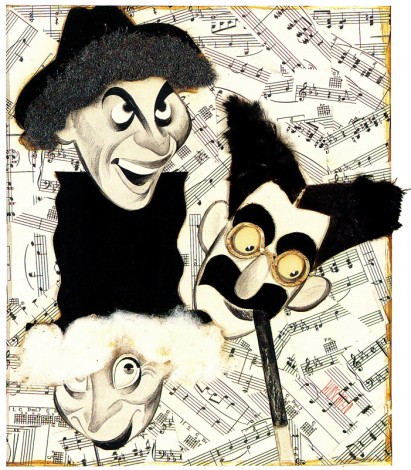
The Night at the Opera 1935, a collage.
(Click any image to enlarge.)
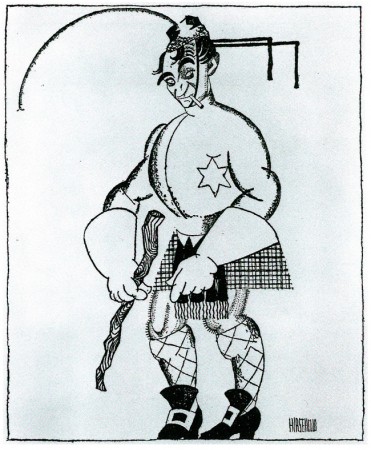
A 1928 caricature of Scottish comedian, Harald Lauder, printed in the NYTimes.
This was one of the earliest published and a good start to a career.
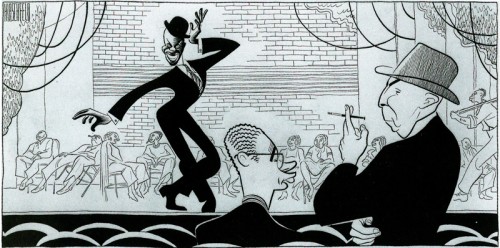
A 1939 drawing of dancer Bill Bojangles in the show, The Hot Mikado.
Designer, Nat Karson and Producer, Hassard Short stand to the right.
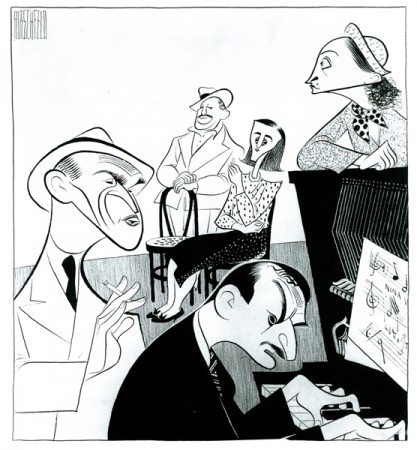
This 1946 caricature of the Cradle Will Rock shows composer,
Marc Blitzstein at the piano surrounded by the cast.
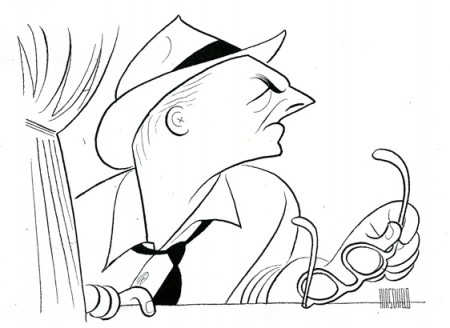
This 1950 caricature of Walter Winchell shows the
style fully formed including the imbedded NINA.
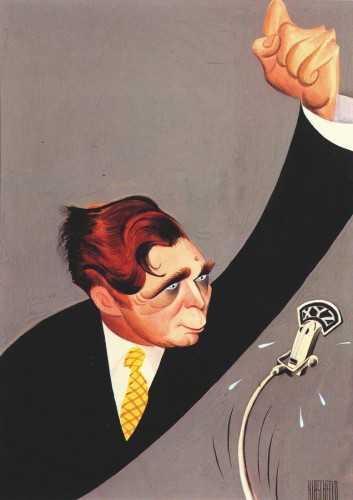
Presidential candidate Wendell Willkie was painted for
American Mercury magazine in May of 1944.
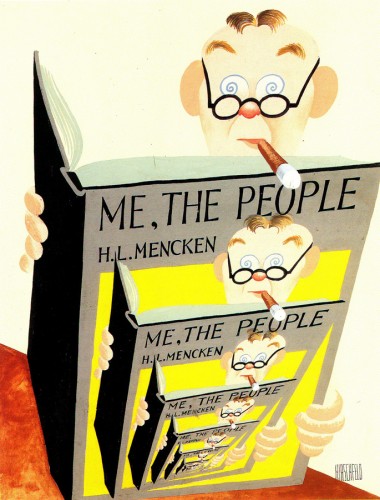
A 1949 painting of H.L.Mencken as the first of a series of covers for
American Mercury magazine, Lawrence Spivak, publisher, commissioned it.
Good caricature is an artform of its own.
Great caricature can be as brilliant as art can get.
Articles on Animation &Bill Peckmann &Books &Disney &Illustration 27 Aug 2009 07:26 am
Good Housekeeping 2
- Before getting into today’s post, I want to make sure you’ve all seen the notation on Tom Sito‘s great blog today. (An amazing and unique blog if there was one.)
- 1968- Former master animator Bill Tytla’s request to return to Disney was turned down. The artist who animated Grumpy the Dwarf, Dumbo and the Devil on Bald Mountain even offered to do a free “trial animation test” to show he still had it. Disney exec W.H. Anderson wrote him:” We really have only enough animation for our present staff.”
Tytla died later that year.
 - This is the second part of my posting of the illustrations from Good Houskeeping Magazine.
- This is the second part of my posting of the illustrations from Good Houskeeping Magazine.
From 1934 continuing into the late 1940′s, they printed four-color full page previews of newly-released Disney shorts. These illustrations were, at first, painted by Tom Wood, and later by Hank Porter.
The Alexander Gallery collected these illustrations in 1987 for an exhibition, and they published a book of them. Bill Peckmann has kindly loaned me his copy of the book.
These illustrations were published recently in the book, Walt Disney’s Mickey and the Gang. It’s a good book which publishes more art than the Alexander Gallery collector’s item. However, the printing in this book feels more glossy and contrasty. The delicacy of the watercolors is sacrificed. That’s why I’m intent on posting them in the better form. However, this book also includes a lot of other info on the animated films and it includes the text originally published in Good Housekeeping.
Here is the second group of pages:
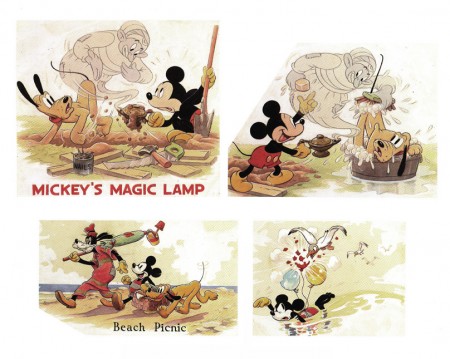
Mickey’s Magic Lamp 1940 | Beach Picnic 1938
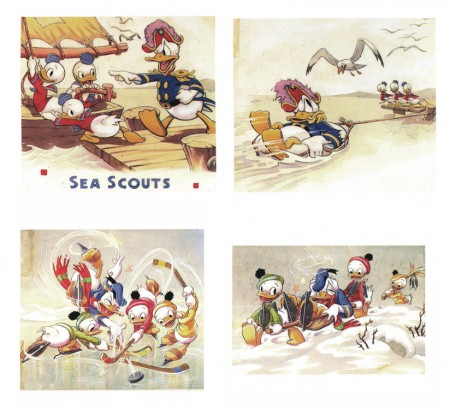
The Sea Scouts 1939 | The Hockey Champ 1939
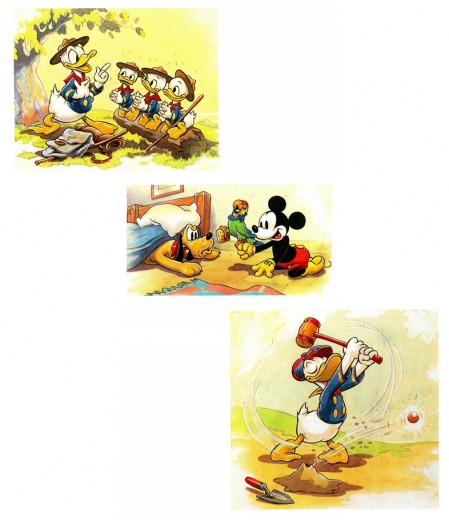
The Good Scouts 1938 | Mickey’s Parrot 1938 | Donald’s Golf Game 1938
Interesting to note the play with Mickey’s ears. These are the ears
with three dimensions used in only a couple of shorts.
Another play on Mickey’s ears – very different.
.
Animation Artifacts &Bill Peckmann &Disney &Models 21 Aug 2009 07:53 am
How To Draw Donald
- I continue with the Art Corner books from Disneyland with the How To Draw Donald classic. I’d received a full set of these books (How to draw Mickey, Donald, Goofy, Pluto and Chip & Dale) when I bought an Animation Kit from them. I’ve started posting these booklets after posting the lecture series that was given to the staff in the 1930′s.
Go here to see the lecture series posts:
Mickey / Donald / Goofy / Pluto
Here to see How To Draw Mickey.
Here to see How To Draw Pluto.
Here to see How To Draw Goofy (Jenny Lerew‘s Blackwing Diaries.)
Here’s the booklet:
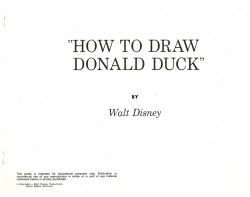 1
1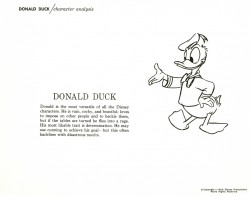 2
2(Click any image to enlarge.)
I don’t have a lot of Donald model sheets to add to this, but these three are interesting.
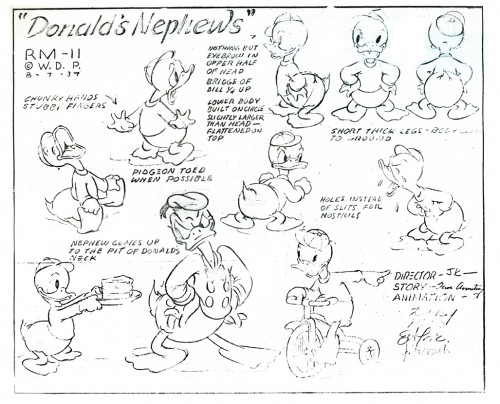
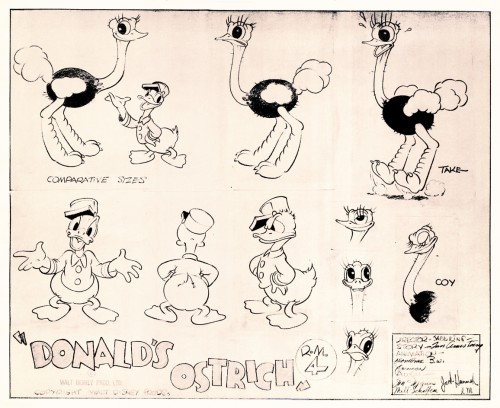
This last model comes courtesy of Bill Peckmann‘s collection. Many thanks.
Articles on Animation &Bill Peckmann &Comic Art &Disney &Illustration 20 Aug 2009 07:20 am
Good Housekeeping 1
 - From 1934 continuing into the late 1940′s, Good Houskeeping Magazine printed four-color full page previews of newly-released Disney shorts. These illustrations were, at first, painted by Tom Wood, and later by Hank Porter.
- From 1934 continuing into the late 1940′s, Good Houskeeping Magazine printed four-color full page previews of newly-released Disney shorts. These illustrations were, at first, painted by Tom Wood, and later by Hank Porter.
Here’s information from the book on Wood and Porter:
- Tom Wood came to Disney Studios in 1932 from his position as a Los Angeles daily newspaper artist. A quiet, hardworking individualist, he was well liked and highly regarded by those who knew him both personally and professionally. He worked at the Studio until his untimely death in 1940 and, as publicity artist, assumed primary responsibility for the monthly Good Housekeeping page as well as the creation of publicity stills for the theater. Since Good Housekeeping was the only magazine for which Disney produced these monthly watercolor sequences, we recognize their scarcity.
Wood typically worked on each of these pages for a full week. Beginning with sketchy, pencilled drawings which he would then ink himself, he also created the final watercolors which represented a 7-minutc Disney film short. Assisted by an “idea man” and a third person who wrote the story or dialogue, the publicity artist had the final approval on the finished version. After Wood’s death Hank Porter would continue working with the magazine well into the late 1940′s. Thereafter, production of these shorts was discontinued as costs became prohibitive and the Studio refused to compromise on quality.
The Alexander Gallery collected these illustrations in 1987 for an exhibition, and they published a book of them. Bill Peckmann has kindly loaned me his copy of the book, so I’ll post the illustrations over a number of posts.
Here are the first group of pages:
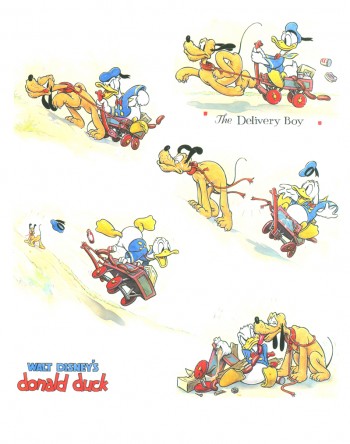 1
1
Donald Duck in “The Delivery Boy” 1938
(L) Donald Duck – Antarctic Troopers 1938
(R) Silly Symphony – The Practical Pig 1938
(L) Mickey Mouse – Society Dog Show 19389
(R) Goofy and Wilbur – Goofy and Wilbur 1939
Mickey Mouse – The Pointer 1939
(L) Donald Duck – Donald’s Date 1939
(R) Donald Duck – Officer Duck 1940
(L) Mickey Mouse – Ice Antics 1940
(R) Donald Duck – Donald’s Elephant 1940
Donald Duck – Billposters 1940
(L) Donald Duck – Donald’s Vacation 1940
(R) Donald Duck – Window Cleaners 1940
(L) Donald Duck – Fire Chief 1940
(R) Donald Duck – Put-Put Troubles 1940
(L) Mickey Mouse – The Little Whirlwind 1941
(R) Mickey Mouse – Big-Hearted Pluto 1941
Donald Duck – Timber 1941
Animation Artifacts &Bill Peckmann &Disney &Models 10 Aug 2009 07:16 am
A Symphony of Models
- The illustrious NY animation designer/director, Bill Peckmann, is sharing a very large archive of material with this site, so I’ll be posting forever to get it up.
Let’s start with model sheets from some of the Disney Silly Symphonies. You’ve possibly seen some of these, but I like gathering them all in one post.
These are from three gems of films. Among the very best of the shorts.
Woodland Cafe is a beauty released March 1937. these three model sheets are signed by Director Wilfred Jackson, animators Paul Allen, Johnny Cannon, Bob Stokes, Leonard Sebring, and storyman Dick Rickard. Other animators include: Cy Young, Izzy Klein, Dick Lundy, Charles Byrne, Jack Hannah and Ward Kimball. (Story supervision was actually done by Bianca Majolie and I’m not really sure the Sebring animated on this film.) Layout was by Terrell Stapp and John Walbridge.
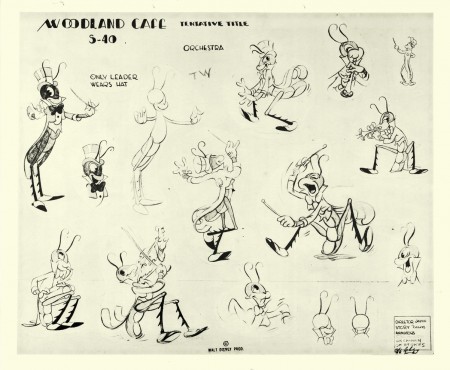
(Click any image to enlarge.)
Farmyard Symphony was directed by Jack Cutting. George Stallings was the story supervisor. Ham Luske signed the sheets for the animators; he was probably the animation director. Animation was done by Eric Larson, Fred madison, John Bradbury, Ken Hultgren, Milt Kahl, Bernard Garbutt, Don Lusk, Paul Satterfield, Lynn Karp, John Sewall, and Paul Busch. Layout was by Dave Hilberman and Art Heinemann.
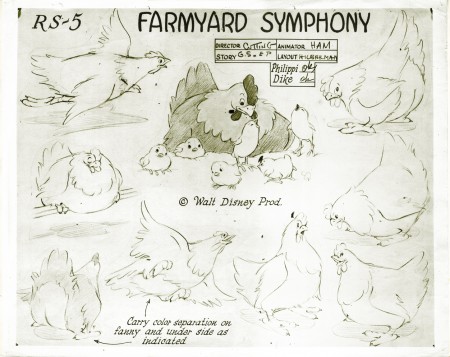
Rel;eased April 1939, The Ugly Duckling won the Oscar and stands out from a lot of the Symphonies of the period. Direction was by Jack Cutting and animation direction went to Ham Luske (which may explain why Luske signed the sheets for Farmyard Symphony as well. Layout was by Dave Hilberman and animation was by Eric Larson, Stan Quakenbush, Riley Thompson, Archie Robin, Milt Kahl and Paul Satterfield. George Stallings was the story director.
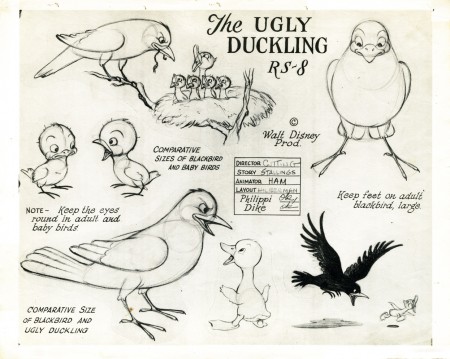
Many thanks to Bill Peckmann. More to come later this week.
.
Daily post 18 Apr 2009 08:46 am
Bits & Pieces
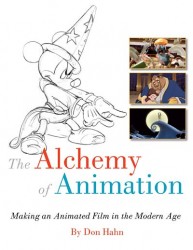 - Michael Barrier has an interesting piece on his site reviewing two Disney books: Amid Amidi’s The Art of Pixar Shorts and Don Hahn’s The Alchemy of Animation. I certainly agree with what Mike has to say. I’d already commented on Amid’s attractive book on this site back in February; as a matter of fact, I actually wrote about all of Amid’s books. I haven’t seen Don Hahn’s new book yet, but, if it’s like his last book, my general feeling was that I wish he’d dig a little deeper. He has a lot to say and he has the ability to write. I’d really like to see him write about the job of producing a Disney animated feature. He’s in a select club, and it’d be interesting to hear his heartfelt comments. Maybe someday.
- Michael Barrier has an interesting piece on his site reviewing two Disney books: Amid Amidi’s The Art of Pixar Shorts and Don Hahn’s The Alchemy of Animation. I certainly agree with what Mike has to say. I’d already commented on Amid’s attractive book on this site back in February; as a matter of fact, I actually wrote about all of Amid’s books. I haven’t seen Don Hahn’s new book yet, but, if it’s like his last book, my general feeling was that I wish he’d dig a little deeper. He has a lot to say and he has the ability to write. I’d really like to see him write about the job of producing a Disney animated feature. He’s in a select club, and it’d be interesting to hear his heartfelt comments. Maybe someday.
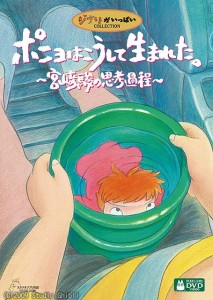 - Ponyo on the Cliff, as you may already know, is going to be released theatrically by Disney in an English language version on Aug. However, if you’re as manic about Miyazaki’s work as I am, you may want to send, in advance, for the Japanese dvd which will be released in July. It includes English subtitles. That edition is available for pre-order now at Amazon.jp.
- Ponyo on the Cliff, as you may already know, is going to be released theatrically by Disney in an English language version on Aug. However, if you’re as manic about Miyazaki’s work as I am, you may want to send, in advance, for the Japanese dvd which will be released in July. It includes English subtitles. That edition is available for pre-order now at Amazon.jp.
There will be two versions of this DVD. There is a basic edition and there is a nine disc set that includes the film, a twelve-hour five-disc making of documentary, and a two disc live performance from Miyazaki’s regular composer Joe Hisaishi. That peculiar documentary is also available on its own, in case you want to wait for the American version of the film and just want this extra. It would appear to me that the extras do not have English subtitles.
To keep up with news of this material, you might want to be watching Daniel Thomas MacInnes‘ excellent site, Ghibli Blog. It was recently remodelled and has an attractive new format. You’ll find 6 excellent clips from this Miyazaki film on this site. (Go here and scroll down a bit.)
- Here’s another site that I’m sure you are all aware of, but it doesn’t hurt to keep mentioning it. The National Film Board of Canada has on their site quite a few of their classic films for viewing, for free. If you’re not aware of these films or haven’t seen them, then got there and look. There are some absolute classic gems there in good editions.
Make sure you at least see the following shorts:
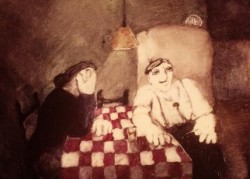 Start with these two Caroline Leaf shorts:
Start with these two Caroline Leaf shorts:The Street
Two Sisters
Then go at random to any of these:
The Sweater – Sheldon Cohen
The Big Snit – Richard Condie
Cat’s Cradle – Paul Driessen
The Great Toy Robbery – Jeff Hale
The Romance of Transportation in Canada – Colin Low
The Tender Tale of Cinderella Penguin - Janet Perlman__________________________Caroline Leaf’s brilliant film The Street
Walking – Ryan Larkin
When the Day Breaks – Wendy Tilby Amanda Forbis
Christmas Cracker – Norman McLaren, Gerald Potterton, Grant Munro, Jeff Hale
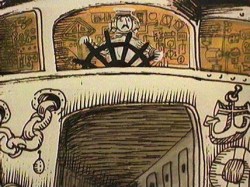 and, it goes without saying that you should know by heart the following Norman McLaren shorts:
and, it goes without saying that you should know by heart the following Norman McLaren shorts:
Begone Dull Care
A Chairy Tale
La Merle
Hen Hop
Now, if I can make a request of the NFB: please add the Hubley short, The Cruise, to this list. It’s rarely seen and an important film in the canon of Hubley’s work.
Hubley’s The Cruise
- In case you’ve missed all the press releases, Fox has a new show premiering on Sunday evening at 8:30 PM Eastern. Sit Down Shut Up comes from the mind of Mitchell Hurwitz. He was the creator of Arrested Development, a writer on The Ellen Show and The Golden Girls. His writing compatriots come from the staff of Two and A Half Men. The voice cast is filled with a lot of talented comedians.
A lotta heavy-duty TV credentials.
There’s a NYTimes article in Friday’s paper which includes a confusing clip. And here’s another article in Saturday’s paper.
The NYDaily News review is headlined: From the Grossout School of Comedy and gives it three stars.
Variety‘s review includes the line: “Seemingly preoccupied with impressing teenage boys, the show should possess scant appeal outside that demo.”
Hmmm.
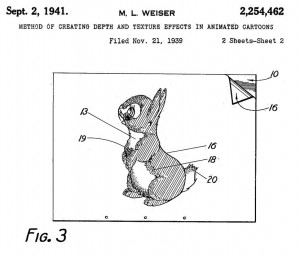 - Far and away, one of the most consistently excellent and important animation sites out there is Hans Perk‘s extraordinary AFilmLa. The documents Hans posts regularly are just incredible. Where does he find them?
- Far and away, one of the most consistently excellent and important animation sites out there is Hans Perk‘s extraordinary AFilmLa. The documents Hans posts regularly are just incredible. Where does he find them?
Currently he’s running a patent filing for “The Blend“. Mary Louise Weiser, head of the Ink and Paint Department at the Walt Disney Studios in 1939, registered two patents for inventions she claimed for the Disney studio.
.
Hans posts all of the patent documents and a brilliant photo of Mary Louise Weiser.
By the way, I also note that the comments on Hans’ site are always so few. It’s impossible to believe that so few have anything to say about the material that’s found there!
Articles on Animation 13 Feb 2009 08:50 am
Heidi’s Song
- Animated features, like some of the shorts, come and go. While working on it, there’s often an expectation that THIS will be the film to catch gold and change history. It doesn’t happen often.
Looking back on a puff piece from some past feature is oftentimes ludicrous; sometimes it’s just sad. Here’s a 1981 story from Millimeter Magazine about Hanna Barbera’s upcoming feature, Heidi’s Song. It sounds like it may be the future, but really it’s even hard to remember the film. It certainly didn’t change the world.
Will HEIDI’S SONG be its SNOW WHITE?
by John Canemaker
Hanna-Barbera Productions Inc. is such a giant corporate entertainment entity that it prompts the old joke: What does a two-ton canary sing? Any damn thing it wants! This Hollywood “canary” tias expanded since 1957 to become the wold’s largest producer of animated TV series andspecials; more recently Hanna-Barbera has become involved in themed amusement parks and live action movies for television.
Now H-B is eager to enter and conquer the sacred Disney domain of fully animated, “quality” feature-length animated films for theatrical release. William Hanna and Joseph R. Barbera hope to do so with an expensive flourish this summer when they will premiere HEIDI’S SONG, a $9 million cartoon feature that has been in production for five years. The film’s staff of 200-plus includes 12 background painters, 60 assistant animators, eight layout people, and 18 top character animators. All cut their teeth years ago at the Disney studio, or at MGM, working with Hanna and Barbera during their halcyon days in the 1940s and ’50s producing Tom and jerry shorts and animated segments for live action features such as Jerry the Mouse dancing with Gene Kelly in ANCHORS AWEIGH.
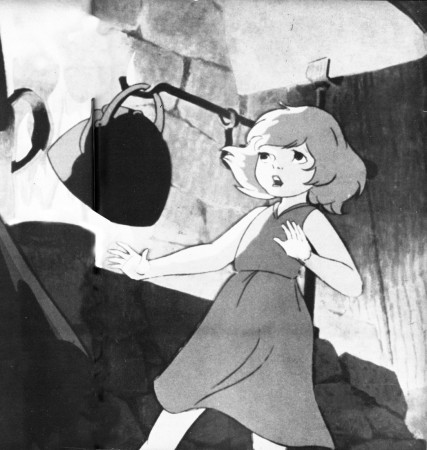
A moment of menace for Heidi whose voice is dubbed in by
Broadway actress Margery Gray in the Hanna-Barbera feature.
Joseph Barbera claims HEIDI’S SONG will be “a step forward in animation that’s very exciting.” But perhaps it will actually be a welcome artistic step back—a comeback of sorts—for Hanna and Barbera, who were once considered by their peers and the public to be superior cartoon craftsmen, winners of seven Academy Awards for two decades of beautifully timed and fully animated Tom and Jerry cartoons. In the 23 years since forming their own company—a factory geared to the production of “limited” animation series, a reduced form of animation that, as an H-B publicity release points out, “ignored the time-consuming and expensive detail that would not be visible on the dimly lit video screen”—Hanna and Barbera have produced over 20 TV specials and some 60 series (“Huckleberry Hound,” “Yogi Bear,” “The Flintstones,” “The Jetsons,” “Scooby & Scrappy Doo,” and so on).
In other terms, H-B produces more film footage in a week today than it did in a year at MGM. The principals’ choice to, as they say, “exploit a niche Disney had missed in family entertainment, with low cost cartoons for television,” has made the two men cartoon tycoons, rich beyond their dreams. They claim “there is not one hour out of every 24 that a Hanna-Barbera cartoon is not entertaining some segment of the world’s population.”
When, in 1967, Taft Broadcasting Company of Cincinnati acquired H-B, the company expanded its operations into five themed amusement parks, including Kings Island (Cincinnati) and Marineland (Los Angeles), where life-sized replicas of H-B characters—Yogi, Huckleberry et al — roam about greeting visitors. More than 1500 licensed manufacturers world-wide turn out 4500 different products bearing likenesses to H-B characters, for example, Flintstone window shades, Scooby-Doo pajamas.
In 1978, H-B won an Emmy, this time for a live action TV movie, “The Gathering,” starring Ed Asner and Maureen Stapleton; more live action films are planned for theatrical release and TV. With all this success, why would Hanna-Barbera bother pouring money into turf that is traditionally Disney’s and has proved to be a producer’s graveyard, from GULLIVER’S TRAVELS (1939) to RAGGEDY ANN & ANDY (1977)?
Company is built on cartoons
One should not forget that cartoons are the heart of the H-B corporate structure (as they are at the Disney studio). And it must be noted that as popular as the TV series are with small children, there is, to Hanna and Barbera’s distress, a persistently vocal, mostly adult contingent that just plain doesn’t like their cartoons! Veteran animator/director Chuck Jones, for instance, dismisses the whole breed of limited animation TV fare as “illustrated radio!” Writer Leonard Maltin once denounced H-B cartoons as “consciously bad: assembly-line shorts grudgingly executed by cartoon veterans who hate what they’re doing.”
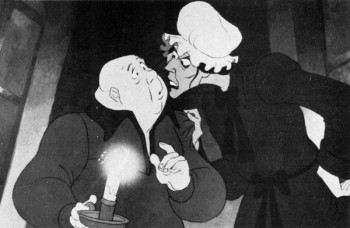 Years of this kind of criticism (and worse from TV critics, parents groups and, most painfully, professional peers) has hit Hanna and Barbera right in their pride of craftsmanship. Witness Bill Hanna’s responses during an interview with Eugene Slafer: “Are you accomplishing what you believe is good TV animation?” asked Slafer. “No, I do not,” came
Years of this kind of criticism (and worse from TV critics, parents groups and, most painfully, professional peers) has hit Hanna and Barbera right in their pride of craftsmanship. Witness Bill Hanna’s responses during an interview with Eugene Slafer: “Are you accomplishing what you believe is good TV animation?” asked Slafer. “No, I do not,” came
__Director Robert Taylor states that HEIDI’S SONG has _______Hanna’s candid reply.
__“a style unto itself, more like a live action picture in_______ To a further probe, “Have
__the staging, as opposed to what you’d see in animation.”____you ever been ashamed of your work, especially since parents have ranted about the general lack of quality on Saturday morning cartoon shows?” Hanna admitted, “Actually I feel like I should crawl under a seat sometimes.”
Joe Barbera recently spoke with Millimeter about his partner’s abilities to recognize the difference between good and bad quality animation and their alleged lack of craftsmanship. “We had to get that stuff out for Saturday morning,” he explains. “That’s a budget problem. Believe me, I don’t stand still for people saying, ‘Oh, they’re doing junk! They don’t know how to do…. ‘We’re not doing that. We only do it because you don’t get the money to do it differently. When we get the money —and you’re talking about millions—we doajob!”
So perhaps the initial thrust for the HEIDI feature came from Hanna’s and Barbera’s desire to prove they haven’t forgotten how to produce animation in the “classical” style, or how to create memorable characters that affect more than an audience’s funny-bone. Of course, Hanna and Barbera are too business-wise to produce a full-animation feature merely to assuage pain dealt their pride; there also had to be a bedrock of financial motivation behind the move and, sure enough, there was. “The thrust,” states Barbera, “was to do one every year and to build a superb perennial library, which Disney had for years.”
The Disney animated features, from SNOW WHITE (1937) to THE RESCUERS (1977), are re-released like clock-work every seven years, just in time to greet a new generation or to remind an older group of their existence. “They are,” says Barbera admiringly, “forever pictures;” that is, films that keep the Disney empire well-oiled with money derived from box office returns (pure profit, since there are no production costs on re-releases), and from lucrative merchandising spin-offs, like comic strips and dolls for themed amusement park rides. This money-making machine depends upon the public’s continuing affection for the cartoon characters and their “classic” stories found in the Disney features. Hanna and Barbera have not yet fully entered this profit arena, but they have been working on it.
Previous animated features
HEIDI’S SONG is not H-B’s first attempt to produce an animated feature. There was, for example, HEY THERE, IT’S YOGI BEAR in 1964 and A MAN CALLED FL1NTSTONE in 1966, both low-cost, limited animation, based on the one-dimensional characters from TV. Neither film was a “forever” picture.
There was,”in 1973, an H-B version of E.B. White’s book Charlotte’s Web, but this, too, suffered from the taint of limited animation and questionable production values. Reviewer Vincent Canby of The New York Times said of the film, “Parents will survive it, and so will the children.” Barbera acknowledges there was “a problem” with CHARLOTTE’S WEB, but to him it was a misjudgment of the financial potential of the material. “Charlotte’s Web,” says Barbera, “is an American classic. It is not an all-world classic. Germany ended up calling it Zuckerman’s Pig, after the name of the man who owned the pig in the story, because who ever heard of a Charlotte’s Web? The film version is recouping some of its money on Home Box-Office TV, on video cassettes and in non-theatrical markets, a fate H-B hopes to avoid for HEIDI’S SONG.
While Disney can produce almost any project known or unknown because of the sales value inherent in the name, “Disney,” Hanna-Barbera is not yet in that sublime position. To the general public, “Disney” means full-animation, perfect technological craftsmanship, beloved characters in stories containing mythic or nostalgic associations. To the same public, “Hanna-Barbera” means limited animation of flat characters on redundant television series. H-B seeks to improve its image with HEIDI’S SONG.
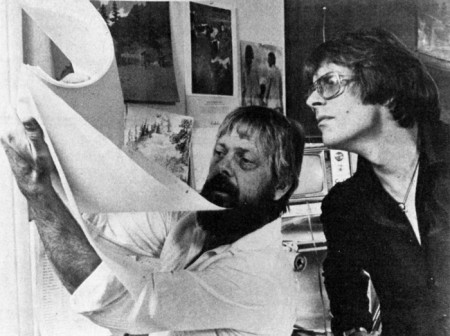
Animator Charlie Downs (left) flips drawings for director Bob Taylor.
HEIDI’S SONG is the story of an orphan girl, based on Johanna Spyri’s 100-year-old, internationally known book. The cartoon feature contains a”Broadway” score of 16 songs by veterans Sammy Cahn (lyrics) and Burton Lane (music). The characters’ voices include Lome Greene as Heidi’s reclusive grandfather, Broadway actress Margery Gray as Heidi, and Sammy Davis, Jr. as King Rat, leader of a band of rodents. Other characters include a “mean and scary ancient housekeeper,” Fraulein Rottenmeier; Sebastian, “the butler who helps Rottenmeier be miserable to Heidi”; Clara, a lonely girl “confined to a wheelchair”; Peter, “a young goatherd, agile as the animals he tends.”
Off-setting the human characters is a gaggle of animals; Spritz, Heidi’s “feisty” pet goat; Hooter, a baby owl who “warns Grandfather of Heidi’s imprisonment in the cellar”; Gruffle, Grandfather’s “gruff old hound”; Schnoodle, a “nasty little dachshund who is rotten like his mistress, Fraulein Rottenmeier.” There is also a “crusty” German Schnauzer, a white mare, a white kitten and the aforementioned royal rat, “the power-loving and peppy leader of the rats in Sebastian’s basement, who spurs his clownish rodents into a strong force to attack Heidi.”
“We do have our animals,” points out Barbera. “My gosh, if we don’t have animals, we’re in big trouble,” he notes with an eye toward audience appeal and merchandising. “But we do have humans and some marvelous dancing,” he continues. “We are not rotoscoping,” he says, referring to the technique of animators tracing frame-by-frame projections of live-action. “I don’t care for rotoscoping at all.”
Choosing talent
Hanna and Barbera have instead hired a team of 20 top character animators—”Let’s use the word humbly and respectfully: the old-timers, “adds Barbera—people like Hal Ambro and Charlie Downs, both of whom specialize in human figure animation and have worked on films such as Disney’s PETER PAN and Richard Williams’ RAGGEDY ANN & ANDY. There are also master animators of animal caricatures and comic timing, such as Irv Spence and Ed Barge, veterans of the fine Tom and ]erry shorts. Th’e great Disney/MGM animator, Preston Blair, was also involved with HEIDI for a time.
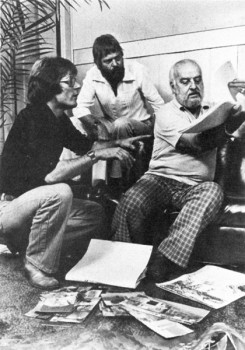 One might assume that the difficult task of manipulating the drawn human form in full animation is what kept the film in production for five long years. Barbera, however, offers this explanation: “When we are in the slow season, which happens in television all the time, everybody has to be laid off. We were going to keep people busy on the feature. We found that doesn’t work. The kind of people you use on a feature are the old super-pros of our industry, and there are few of them left.
One might assume that the difficult task of manipulating the drawn human form in full animation is what kept the film in production for five long years. Barbera, however, offers this explanation: “When we are in the slow season, which happens in television all the time, everybody has to be laid off. We were going to keep people busy on the feature. We found that doesn’t work. The kind of people you use on a feature are the old super-pros of our industry, and there are few of them left.
“Secondly, we wanted to use HEIDI’S SONG as a training ground for new animators. The first three or four years the picture would go into production and stop, then go back into production and then stop. That was not good for the picture. We were losing momentum, the enthusiasm of the artists and the excitement we wanted to build up. So finally, about a year and a half ago, we marshalled the last remnants of
__Bob Taylor, director, and animators____ what we think are the best people in the
__Charlie Downs and Hal Ambro. ________business. When we brought these people in we had to change directors. We had a fine guy, but he had forgotten how to go back and really work these old-timers — really get the good animation! We then hired a brilliant young director, Bob Taylor, who is dynamite!”
Prior to rejoining H-B a couple of years ago (he had first worked there in 1966 for one year), Robert Taylor worked for Ralph Bakshi, Steve Krantz, DePatie-Freleng and Murakami-Wolf. “I always seem to come in on things that are hopeless,” he commented recently, “and we try to turn them into hopeful. I think we’ve done it with this picture. For me and the whole crew, and for Joe and Hanna-Barbera and Taft, this is our entrance into real good quality stuff!”
It has not been a piece of cake for Taylor. When he took on the HEIDI assignment, the script was written and the tracks were already recorded. “It was a hang-up for me,” he admits. “That’s the albatross around my neck. The story is episodic. If I had written it, I would have made it a little stronger in terms of her emotions and some of the dialogue. But,” he adds brightly,
I “my whole trip is to keep the audience entertained—get people to go to animated films and make them feel when they come out that they’ve seen something they can’t see anyplace else. It isn’t so much the tools;
i it’s what the hell I’m trying to do with it.”
Trying to elicit a description of the film’s style from both producer and director is difficult. According to Barbera, “The results have been what I call a Hanna-Barbera feature. It is not going to look like a Disney picture, or a FRITZ THE CAT or a RAGGEDY ANN & ANDY. We have our own style.” When pressed, Barbera cites “some very imaginative pieces of business.” Pressed further: “We’re not holding back. When they lock Heidi in the cellar, that’s a scary place—to be locked in a basement in a house in Frankfurt in the 1880s, that’s enough to put you away. We’re not holding back, yet we’re keeping it in good taste throughout.”
New wave animation
Taylor was a bit more specific: “I hate to opportunity for the guys to get back into what it’s really all about. We take as many new animators as we can bear—the ones that have the enthusiasm and are really interested in what we’re calling a ‘renaissance.’ But even more important, we are just interested in making great animated films and updating them into the 1980s.”
The HEIDI unit has already begun production of its next two animated features, ROCK ODYSSEY (which Barbera describes as “a marvelous treatment of music from the 1950s, ’60s and 70s. A rock-FANTASIA, if you want to call it that”), and NESSIE COME HOME, a tale about the Loch Ness monster. Again, the thinking behind the choice of both projects is carefully calculated toward maximizing box office. “If you are going to do a feature,”reasons Barbera, “you must have something people will identify with. You can’t do ‘Willie the Glowworm!’ That’s why HEIDI is so great. It’s always a problem finding material. Watership Down is a marvelous book, but we would have hesitated to do it because it’s just not that well known. It’s a gamble. You have to put four to five million dollars into something like that.”
Marketing concepts for animated features
At a time when Disney films are attempting to woo an older (“PG”) audience, one wonders why Hanna-Barbera appears to be aiming toward a traditional, family-oriented “G”-rated audience with its animated features. Barbera explains: “First of all, anything that Disney has done is going to play forever, so he will have that constant market in every media. Secondly, the theater audience isn’t going to be the only audience. There are going to be cassettes, a perennial that will run forever. And thirdly, we are going to have our own style. We’re not going to have a picture that will be only for kids. We will get the adults with this one.”
“ROCK ODYSSEY,” continues Barbera, “will appeal to those between the ages of 18 and 35, but we will not lose the kids because of the animation. And we will have the adults that remember those ’50s and ’60s songs. NESSIE will have a great, I hate to use the word, ‘environmental’ appeal, but we will be protecting a character that’s getting it. If there are monsters in that lake, they get bothered—by submarines, depth bombs, cameras—more than any character in the world. We have a very unusual twist that will make it appealing.”
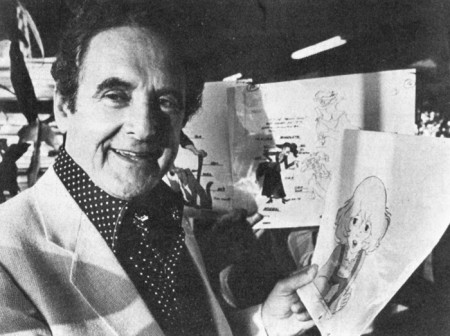
Joseph Barbara, executive producer, displays color models that some
150 animators used for reference while working on HEIDI’S SONG.
Asked whether the future might see Hanna-Barbera producing adult-oriented features a la Bakshi, Barbera answers, “Oh yes, very much! We had a recent all-day meeting where the thrust was the fact that we can’t depend on the children audiences to pay for these things. We must attract the adults, too. Statistics show there are less children around now. So whatever we do, we must attract the adults.” Barbera must have been thinking of a recent Bakshi product, i.e., LORD OF THE RINGS, for when asked if he would produce an unquestionably adult cartoon such as HEAVY TRAFFIC or FRITZ THE CAT, he replied, “No! I don’t think we would do that! We certainly wouldn’t shy away from a gutsy project, but it must bring in the kids, too. So there would be no bad taste.” For the time being, it is significant that Hanna-Barbera is training an enthusiastic crew in the techniques of full, character animation, one form of the art that for the last two decades has seemed to teeter constantly on the brink of extinction. It is enough for now that H-B is producing with integrity and care a film like HEIDI’S SONG, which will attract and appeal to large audiences.
The success of Hanna-Barbera will keep an avenue open for future animated features, and hold the public’s awareness of and interest in the medium of animation itself. With an increase in the number of future animated features will come diversity in form and content. Animation
as a vital and viable entertainment medium will then come closer to realizing its potential, as it did in 1968 when George Dunning directed YELLOW SUBMARINE, and in the early 1970s, when Ralph Bakshi excited audiences, and, indeed, as in 1937 when a struggling young producer named Walt Disney redefined the genre.
Daily post 06 Dec 2008 09:53 am
Taking stock
- There were a couple of great blog posts this past week.
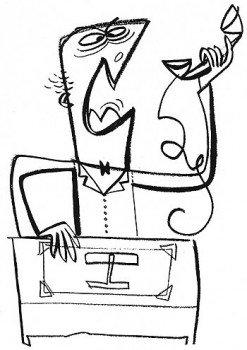 Amid Amidi, on Cartoon Brew, gave us one of the blockbuster pieces of the year. He catalogued a number of Asian-Americans who worked in animation during the golden years and offered a brief bio of them as well as links to more information on all. It’s quite a serious bit of writing and I’ve saved it for my own records. I don’t think anything comparable has been done before re animation’s history.
Amid Amidi, on Cartoon Brew, gave us one of the blockbuster pieces of the year. He catalogued a number of Asian-Americans who worked in animation during the golden years and offered a brief bio of them as well as links to more information on all. It’s quite a serious bit of writing and I’ve saved it for my own records. I don’t think anything comparable has been done before re animation’s history.
The amount of work Amid put into this could only have been enormous, and my gratitude couldn’t be stronger. I assume most of the readers of my blog have seen that post; if not go. Here’s the link again.
- Speaking of Amid, he’s also updated his other site, Cartoon Modern. He’s started the Cartoon Modern Tumblr where he intends to post a picture a day of art from the period. The drawing to the left, from the Tumblr is by Ed Benedict.
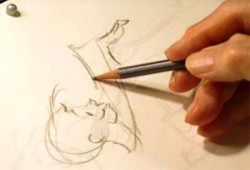 - Mark Mayerson pointed us to the upcoming celebration of Chuck Jones’ work on TCM next March. This is all centered around the new documentary Chuck Jones Memories of Childhood, directed by Peggy Stern. The film records a conversation with Chuck Jones as he reminisces about his childhood in 1920′s Los Angeles. The half-hour program blends family photos, clips from classic Jones shorts and original animated sequences directed by John Canemaker, drawn from drawings Jones made during the interview filmed in 1998.
- Mark Mayerson pointed us to the upcoming celebration of Chuck Jones’ work on TCM next March. This is all centered around the new documentary Chuck Jones Memories of Childhood, directed by Peggy Stern. The film records a conversation with Chuck Jones as he reminisces about his childhood in 1920′s Los Angeles. The half-hour program blends family photos, clips from classic Jones shorts and original animated sequences directed by John Canemaker, drawn from drawings Jones made during the interview filmed in 1998.
Some of the Jones shorts to be screened include: Prest-O, Change-O (1939), Sniffles and the Bookworm (1939), Elmer’s Candid Camera (1940), Duck Amuck (1953), One Froggy Evening (1966), What’s Opera Doc (1954), and The Dot and the Line (1965). Mark gives the complete schedule.
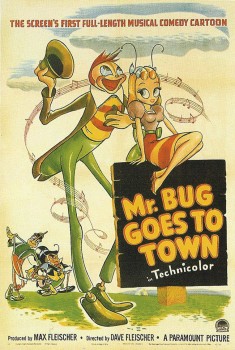 – Over the Christmas holidays the Film Forum will be screening a beautiful 35mm print of Fleischer’s second feature, Hoppity Goes To Town.
– Over the Christmas holidays the Film Forum will be screening a beautiful 35mm print of Fleischer’s second feature, Hoppity Goes To Town.
This remarkable film opened Dec 4th, 1941. Pearl Harbor occurred three days later, and the fate of the feature’s financial success was settled. Paramount closed the studio and fired the Fleischer brothers.
Dec. 24th through Jan. 1st you can see the film paired with “Betty Boop’s Rise to Fame,” a 1934 short starring Betty and Max Fleischer.
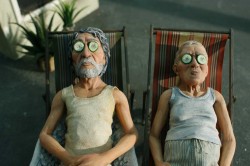 Tatia Rosenthal‘s feature, $9.99, is about to make its debut in LA with an Oscar qualifying run at the Laemmle Theater. The film is a stop-motion feature done in Australia. It stars the voices of Oscar-winner Geoffrey Rush (“Shine”) and Golden Globe winner Anthony LaPaglia.
Tatia Rosenthal‘s feature, $9.99, is about to make its debut in LA with an Oscar qualifying run at the Laemmle Theater. The film is a stop-motion feature done in Australia. It stars the voices of Oscar-winner Geoffrey Rush (“Shine”) and Golden Globe winner Anthony LaPaglia.
You can watch the trailer here.
The film’s website can be found here.
If you live in LA, make the effort. Support the film, check it out.
- There’s a newish blog in town (meaning NYC) that’s worth the visit. It’s an addition to the ASIFA-East website. Called The Exposure Sheet (do studios other than mine still use these things?) it reports on business and events involving NY members of ASIFA.
The most current of these articles is the big lay-off of workers at Nickelodeon and the shutting of the doors of this last big network studio in NY.Linda Beck writes an informative piece about the actual events occurring here, and for a reality check it’s worth the read.
The article listed above has been removed from the blog. There’s no given reason. Perhaps Linda felt she’d misstated something. Perhaps someone will post something more.
- Finally a big congratulations to Nina Paley. Her film, Sita Sings the Blues, won the Gotham Independent Film Award. Theater Near You category. It took home the $15,000 prize from Artists Public Domain and D.R. Reiff & Associates.
Nina’s also been been nominated as “Someone to Watch” for this year’s 24th Independent Spirit Awards. That’s a brilliant coup for Nina. I believe this is the first time an animated film has been nominated for a ‘Spirit” in any category, and if there’s any justice in the world she’ll win. I’ll be watching on Feb. 21st with fingers crossed.
